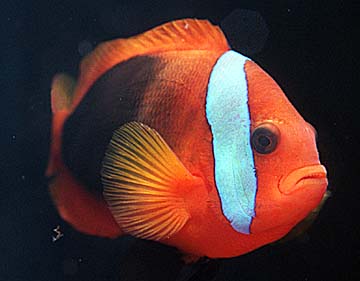


Hawaii expected
to lead aquarium
animal business
A conference here next month
By Helen Altonn
could help expand the
burgeoning industry
Star-BulletinRichard Masse, 28, is banking on accelerated growth of Hawaii's aquarium animal industry in the next five to 10 years with two big personal goals: "To be at the head of the wave, so to speak, and to be the best of them."
Masse came here in 1997 and started Mangrove Tropicals, a commercial marine ornamental fish farm on Campbell Estate property in Windward Oahu.
The United States holds the biggest chunk of the industry, worth about $125 million to $150 million, he said. Adding aquariums, tanks and related apparatus pushes the value of the industry to more than $1 billion, Masse said.
The young aquaculture farmer will be among speakers at Marine Ornamentals '99, the first international conference on marine ornamentals, Nov. 16-19 at the Hilton Waikoloa Village, Kailua-Kona.
State economic development specialist Richard Fassler says Hawaii is expected to emerge as the leader in the rapidly increasing business of marine ornamental aquaculture. Hobby aquariums are second only to photography in U.S. popularity, he points out.
For further information about the Marine Ornamentals '99 conference, call state economic development specialist Richard Fassler, chairman of the marketing committee, 587-2775, or e-mail rfassler@dbedt.hawaii.gov. INFO TO THE GILLS
Among key speakers at Marine Ornamentals '99:
Martin Moe of Florida, who pioneered aquaculture of marine ornamental fish and has written many books on the subject.
John Dawes, executive director, Ornamental Fish International, a large industry trade organization based in Spain.
Charles Delbeek of Waikiki Aquarium, coral and marine ornamental fish expert.
But wild fish and coral resources may not be sustainable because of methods of collecting them in some countries, he said. For example, he said, cyanide is used in the Philippines -- stunning the fish and killing the coral.
Marine ornamentals also include giant clams, marine invertebrates, rocks and plants.
Gerald Heslinga, president of Indo-Pacific Sea Farms in Kailua-Kona, said the conference could greatly expand the industry.
Marine organisms are a big issue among hobbyists and public aquariums because of concern that the increasing demand and capture of saltwater fish will damage the ecosystem, said Bruce Carlson, Waikiki Aquarium director.
A pioneer in stony coral culture, Carlson is one of two honorary chairmen for the conference. The other is Martin Moe of Florida, pioneer in the commercial culture of marine ornamental fish and author of many books on the subject.
Carlson said, "A major concern worldwide is that coral reefs are not getting any better and in many areas are seriously degraded." There are a number of endangered species of coral reef fishes, he said. While none has become extinct, he said better methods are needed to collect the organisms and try to raise them."
Masse said he's beginning production of clown fish and other species of ornamental saltwater fish on two of his 18 acres, "and we're pretty happy where we are right now. ... We generally work with what the industry is able to do now with technology."
Masse is optimistic about the future, pointing out that captive-bred animals rather than imported fish now dominate a large freshwater ornamental industry. He believes a similar shift will occur with saltwater ornamentals.
Carlson said everybody is working on various aspects of the marine ornamental problems. At the Waikiki Aquarium, he said, "We're making significant headway in learning how to raise the Hawaiian seahorse, which has never been done before. ... We're close to having a first on that."
Nobody's advocating that people stop collecting, but there are huge reef issues, Carlson said, noting a battle between dive operations and fish collectors in Kona.
"It's not a matter that collecting is driving any species to extinction, but a matter of resource allocation: Who gets what and how do we decide?"